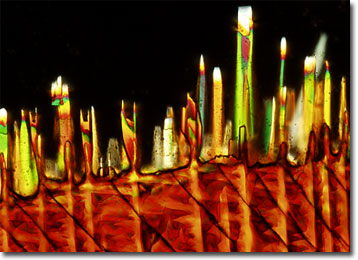Polarized Light Microscopy Digital Image Gallery
Chloroisatin
The beginnings of the chemical industry go back several thousand years to the Middle East, where alkali and limestone were refined for glass production, and to Phoenicia, where soap was first developed. Since these early efforts, the field has expanded phenomenally, existing today as a multi-billion dollar industry in the United States alone.

View a second image of Chloroisatin
The first mass producers of chemicals became active in the 1800s, and over the last two centuries scientific and technological advances have made a tremendous number of chemical substances available. Some of these many chemical products are meant to be directly utilized in the form in which they are sold, as is the case with pharmaceuticals. However, a great number of the substances produced by the chemical industry, including chloroisatin, are intermediates, which are intended to be used as a middle stage in the manufacture of some other desired end product. Indeed, the majority of synthetic processes are based upon the transformation of one or more readily available and often inexpensive intermediates, and, therefore, a vast array of these substances are commercially available through chemical supply companies.
Chloroisatin is a chemical intermediate that usually appears in the form of a yellowish-red crystal. Comprised of eight carbon, four hydrogen, one chlorine, one nitrogen, and two oxygen atoms, the substance exhibits a molecular weight of 181.5. One of several different isatins currently available, chloroisatin is a versatile substrate that can be utilized to synthesize a wide range of heterocyclic compounds, such as quinolines and indoles. The chemical intermediate also frequently finds use as a raw material for pharmaceutical synthesis and has been recently involved in efforts to create new anticonvulsant drugs.
